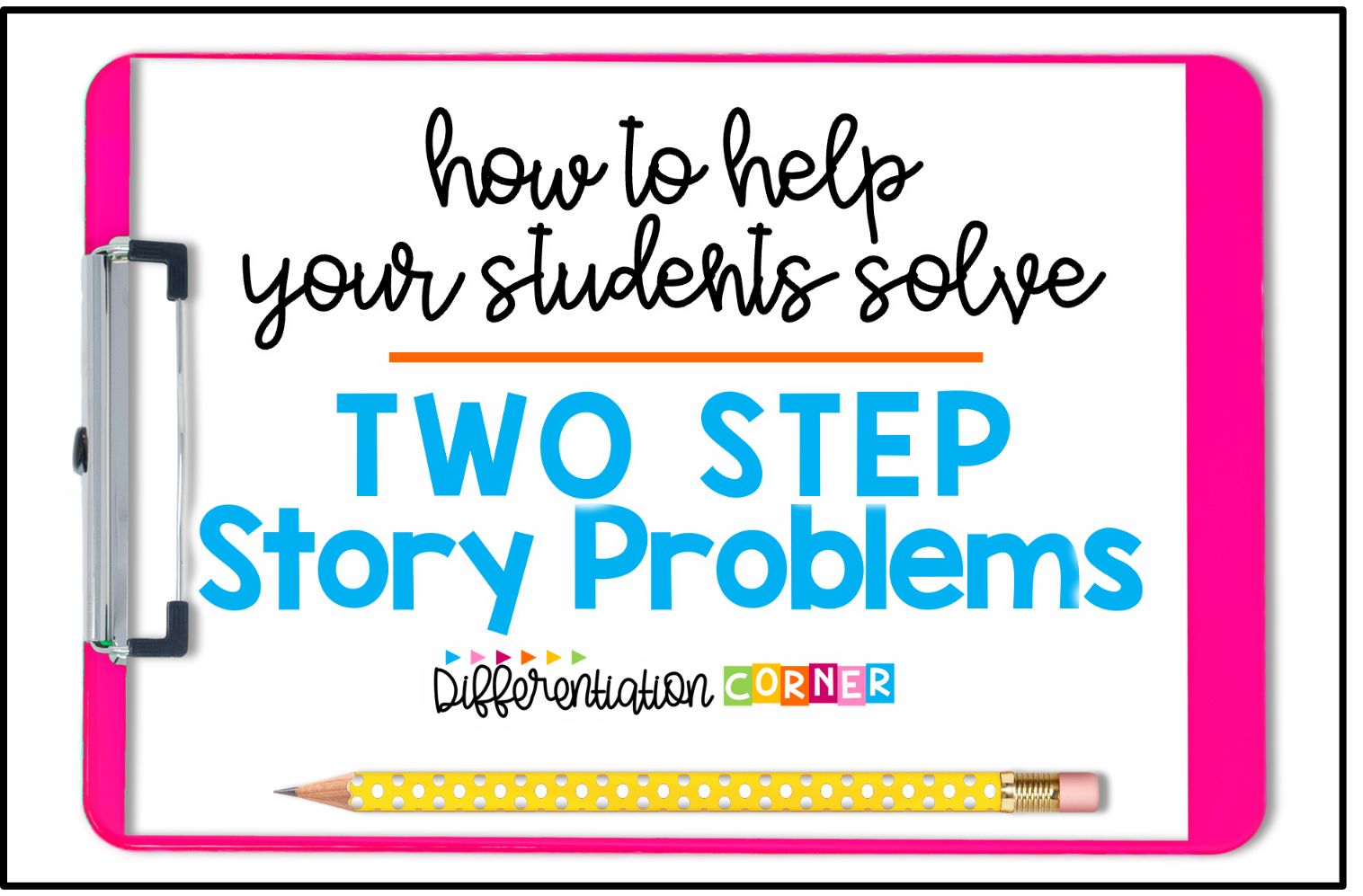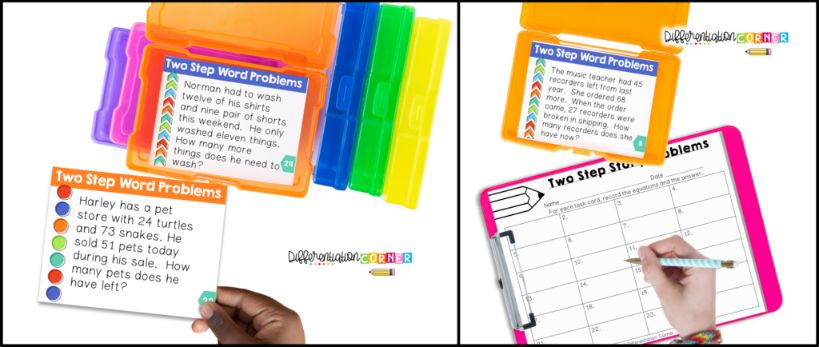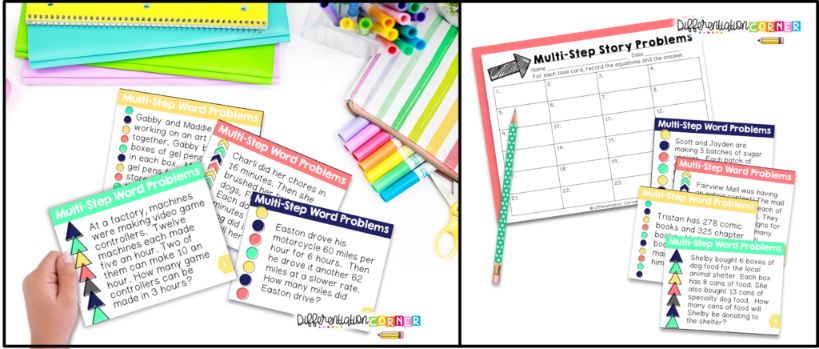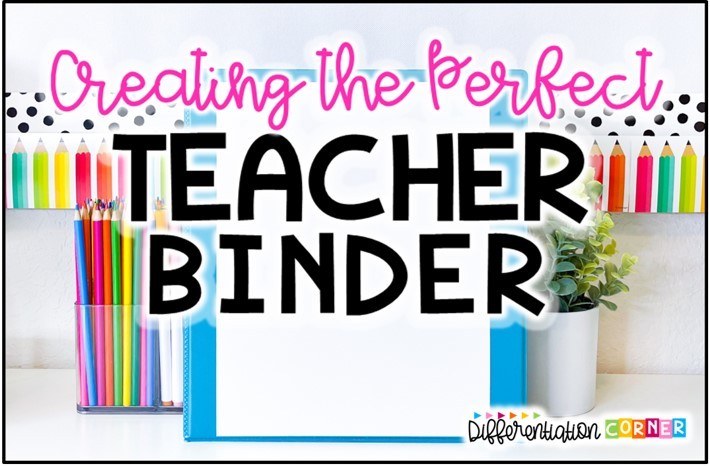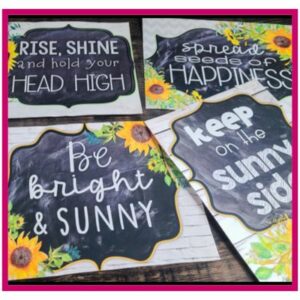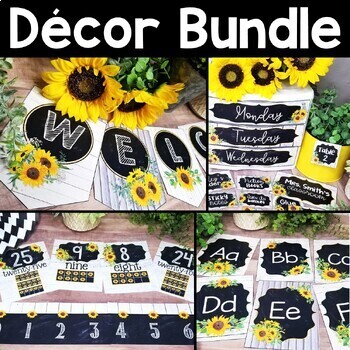Two step story problems can be so tricky to master, but they are so important. In fact, they are honestly they are probably the most real world math problems your students will encounter in school. Now add in multiple steps and you’ve just created a kids worst nightmare! Many students just look for the numbers in the story problem and just pick a random operation! Or worse yet, many students just stare blankly and give up.
Practice One Two Step Story Problem at a Time
If your students seem be getting overwhelmed with word problems, you can zero in on one at a time to make the task seem more manageable. This strategy is great for struggling students ore students in special education. Task cards are great for this! If you know me, you know I love the versatility of task cards! See some fun ways to use them here.
Read the Entire Multi-Step Word Problem
Read it slowly sentence by sentence. This first part is all about good reading comprehension. Read the whole two step story problem at least once, but read it as many times as needed.
Identify the Question
This is half the battle when it comes to two step story problems! Sometimes there is extra information. We underline the question. For my struggling math students, I have them locate the question mark and then find the beginning of the sentence.
Write an Answer Statement
Writing an answer statement with the correct label really helps my students stay focused on what the correct answer will look like. I find that it helps to use this strategy right after identifying the question in the two step story problem.
Here are some examples of story problem answer statements could look like.
Brenda has _____ watermelons left.
Carlos used ____ ounces of cheese.
Landon practiced ____ minutes.
Visualize What is Happening in the Story Problem
Students can even close their eyes to picture what is taking place. Here are some examples of how to model your thinking when teaching two step story problems in math!
Ben baked 48 cupcakes. What flavor are they? Are they in one of those clear plastic containers?
Ben gave 12 to his friend Juan. Imagine Juan taking cupcakes from Ben. Are they in a fancy box? Do you think Ben has a bakery?
Ben gave 24 to his neighbor for her birthday party. Picture Ben taking some cupcakes over to his neighbor’s house. Do you think Ben is invited to the party?
How many cupcakes does Ben have left?
Brenda had 25 watermelons in her cart at the store. Picture her cart overflowing with watermelons! She’s struggling to push it to the register.
Three watermelons fell out and broke. Oh! What a mess! I bet she was embarrassed!
Brenda put 7 more watermelons in her cart. Will all of those fit!?! Maybe they’re small watermelons?
How many watermelons does she have in her cart now?
They really need to see it as more than just some numbers on a page. Students need this visualization of two step story problems modeled over and over again before it becomes second nature to them. This visualization strategy is so useful once students have it mastered! They can even transfer this strategy to other math problems and reading comprehension!
Act it out
Students can make visual models, diagrams or even draw pictures. When students can see story problems as actual scenarios it can help them to understand how to solve them much easier!
Students can use simple manipulatives like index cards, counters, and snap cubes. Using actual concrete objects is one of the best ways to internalize the information in the story problem. Nothing really beats hands on learning. Its fun and engaging and students can physically add, subtract, divide or multiply with their tangible objects. Incorporating movement helps students understand story problems.
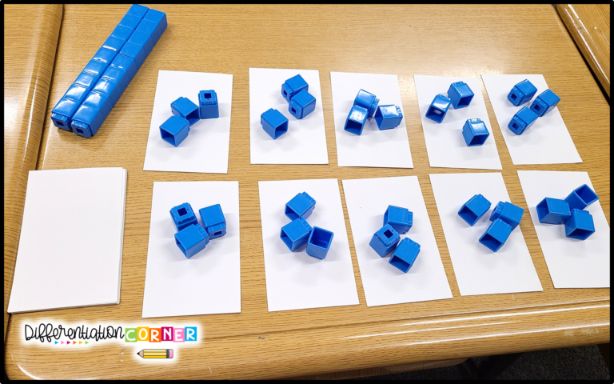
After students have mastered physically acting out multi step word problems, then we move to creating simple visual models and diagrams with labels to represent what is happening in the story. I tell students that we aren’t in art class, so only simple pictures like circles, squares & rectangles will be drawn. They can be a bit more elaborate if they need to keep track of what represents what in their work. Drawing visual models helps provide scaffolding for students while they’re figuring out each step of the two step story problem and what operation is needed.
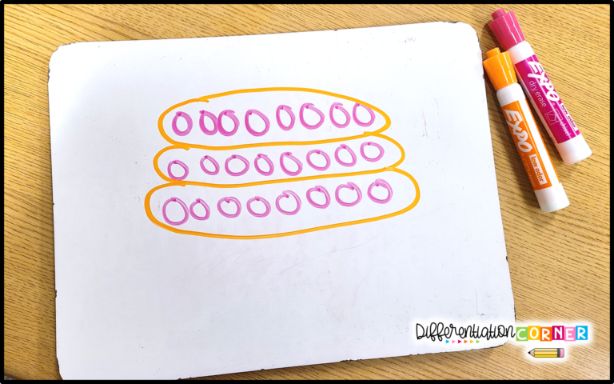
What Do I Need To Do To Find Out The Answer
Now its time to figure out our situation to determine the steps and operations we will use to solve this word problem. Are we trying to find a part or a whole? If we are trying to find a part, then we should subtract or divide. If we are trying to find a whole, then we will use addition or multiplication. Using key words to determine our operations is a good start, but key words aren’t always accurate. I honestly just have my students think about the situation instead of looking for key words. It takes longer to teach, but it works better in the long run in my opinion.
Practice Two Step Word Problems Often
Every day practice of two step story problems is ideal. One way to keep students skills sharp is to incorporate a problem of the day approach. An easy was to do this is to write a two step story problem on the board. Keep the types of problems fresh by using all of the operations and going back to include past math concepts of math you’ve taught. Like area, weight, metric units of measure, etc. You can also add them to your daily math rotations!
Everything we do takes practice, and so does mastering two step story problems! Daily story problems in math will ensure that they are encountering different types of story problems and help your students be confident problem solvers.
If you’re looking for some two step story problem practice for your students, I have created a couple of sets!
These two step story problem task cards are perfect for students to visualize multiple steps with addition and subtraction.
These multi step word problems are great for practicing addition and subtraction with multiplication!
I hope this has given you some ideas for teaching two step story problems in your classroom! Id love to answer any questions you might have or talk about any other thoughts you have on two step story problems in the comments!







